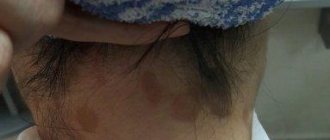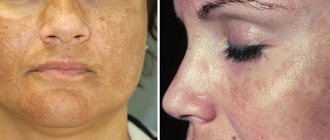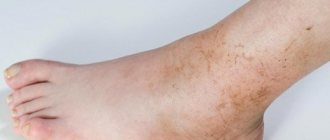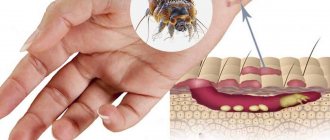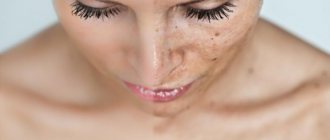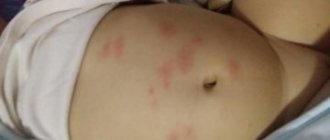Pigment spots on the abdomen are skin rashes, the cause of which is considered to be a hereditary predisposition, a disorder in the production of melanin, or diseases of the internal organs. In some cases, spots appear during pregnancy or due to hormonal imbalance. In themselves they do not pose a danger, but are a consequence of internal changes in the body.
Features of pigmentation on the abdomen
The skin phototype is determined by melanocyte cells, which produce a special substance – melanin. It protects the epidermis from ultraviolet radiation and negative reactions. Fair skin suffers from melanin deficiency and is therefore more susceptible to pigmentation - especially in the summer. If the production of the dye is disrupted, brown spots appear throughout the abdomen, which have smooth edges and a dark tint.
If spots appear on the abdomen, it means that melanocytes produce pigment in excess. In addition, the following may form on the body:
- Freckles are small yellow rashes that appear on the face, arms and stomach. They have a uniform color and turn brown when exposed to sunlight. There are two types of pigments - those acquired by inheritance (small and round), and those obtained after exposure to the sun (large, with uneven edges). This pigmentation is not dangerous and goes away with proper treatment;
- moles or nevi are brown spots on the stomach or other parts of the body. They can come in various sizes, shapes and colors. There are dark brown, pink and red moles. How to identify a nevus: a spot first appears, which eventually protrudes above the skin. Neoplasms are benign, but under the influence of ultraviolet rays they can degenerate into a tumor;
- A birthmark is a pigment cluster that has been on the body since birth. If a pigment spot appears on a child’s stomach, it must be monitored: any changes in color, shape and outline indicate the development of melanoma. This disease occurs after an excess accumulation of melanin and causes skin cancer;
- chloasma is a collection of spots of various colors and shapes. It occurs in pregnant girls due to hormonal changes in the stomach and hips. May appear due to liver and kidney disease. Sometimes the child’s belly is stained for immune diseases;
- lentigo – occurs in adolescents, adults and the elderly. Due to the disease, round brown or yellow spots may appear on the stomach and arms. This pigmentation is not harmful to health;
- Vitiligo is a skin disease that causes white spots to appear on the body. They form pointwise, but grow over time. In these places the hair is white, and the dermis is insensitive to irritation.
Moles can disappear after a while or remain for life. When diagnosing, doctors advise removing birthmarks on the stomach, groin area and back. Moles should be gotten rid of only if they are located in places that are subject to injury.
Integrated approach and UV protection
Any problem must be treated comprehensively, just like pigmentation on the face. The effectiveness of complex cosmetic products in the treatment of brown spots has been clinically proven. The action of such drugs occurs in two directions:
- Providing local therapeutic and cosmetic results.
- Provides protection from the harmful effects of ultraviolet radiation.
These products include the complex drug Neotone, which uses a serum with such modern ingredients as licorice, alpha-arbutin, Lumiskin. It is intended for night skin care. Also highly effective products include Radiance with an increased degree of protection SPF50+, which provides morning care to the skin. This is a very effective product, it performs all stages of facial skin care. In addition, it is a caring and cosmetic product that acts as a safe means of preventing age spots.
Causes
The main causes of age spots on the stomach:
- allergy;
- infection - rubella or scabies;
- stomach or gastrointestinal diseases;
- mental illness;
- improper hormone metabolism;
- disruption of the endocrine system;
- heredity;
- improper production of melanin.
The exact diagnosis and causes of the rash can be determined by a dermatologist after a thorough examination. If a dark pigment spot appears on the abdomen, this may be accompanied by various symptoms.
Using them, the cause of the rash can be determined at home.
Reddish spots appear due to taking medications or eating allergenic foods. They also form on the abdomen as a reaction to insect bites. If the redness does not go away for more than a week, this indicates a chronic disease due to improper functioning of the liver or kidneys. However, they may itch and resemble blisters.
When an infection occurs, lichen forms on the skin. According to the description, the pigments have round, even outlines and are filled with liquid. If you have ringworm, the rash must be treated, otherwise bacterial infection may occur. Most often, the disease occurs in men against the background of sexually transmitted infections.
Dark pigments form on the abdomen during hormonal imbalances, during pregnancy, and also in the postpartum period. You can get rid of them with special treatment using ointments and creams.
There are hereditary causes of pigmentation that are associated with impaired melanin production: spots appear on the back, stomach and legs. It only occurs after salon cosmetic procedures.
We recommend reading
- Causes of the appearance and itching of pigmentation on the back
- Pigment spots on the neck: provoking factors and diagnosis
- Why do white spots appear on legs?
The essence of the problem
Pigment spots are characterized by a high concentration of melanin in certain areas of the skin. You may notice the formation of moles or freckles if this substance is deposited in the upper layer of the epidermis. They usually do not cause any problems or discomfort.
Hyperpigmentation is caused by the accumulation of melanin in deeper layers, resulting in the formation of dark brown spots on the skin surface, which can sometimes even appear slightly prominent.
Features of age spots during pregnancy
A pigment spot on the abdomen has a certain shape during pregnancy: the color of the epidermis changes, a brown stripe appears from the navel to the pubis. It is called Alba, and is formed only after a woman becomes pregnant. The rash appears on the thighs, chest and face.
Abdominal pigmentation disappears after childbirth. Sometimes darkening of the nipples occurs - this is due to the production of hormones, and goes away on its own after a period of feeding. If there is a tendency to develop freckles on the face, then the risk of spots forming around the navel when carrying a child increases several times.
Appearance of pigmentation
Brown spots on the face occur in both young and older people. Most often they form between 40 and 50 years. These are the so-called brown age spots on the face. It is extremely rare that pigmentation can disappear spontaneously without any treatment. As a rule, stains tend to grow, and in order to get rid of them, you need to make a lot of effort.
What to do if brown spots appear
The peculiarity of spots in the abdominal area is their random disappearance after a short period of time. Bright pigments, similar to nevi, can disappear within a few days after taking antibiotics. And small formations during pregnancy can be removed independently using traditional methods.
The first thing you need to do when a dark spot appears on your stomach is to undergo a comprehensive examination and make an appointment with a dermatologist. These are the main conditions under which the exact cause of formation can be determined.
If the pigment changes color, resembles a bruise, or grows from a birthmark, you should contact an oncologist and donate blood for biochemical indicators.
Treatment of a dark spot is possible at home only after consultation with a specialist.
Treatment methods
If the spots are red or pink, then the cause is an internal infection. In this case, medications are prescribed that contain keratolytics and fungicides. Efficiency differs:
- Clotrimazole - taken three times a day;
- ten percent sulfur ointment - applied twice a day to the affected skin;
- ointment with salicylic acid - used as a replacement for sulfuric ointment.
We recommend reading
- Treatment with folk remedies for age spots on the face
- The danger of pigment spots on the skin
- The effectiveness of Melanativ cream against age spots
Freckles can be removed with cosmetic procedures in the salon. The accumulation of pigments can be observed in different layers of the skin: in the epidermis (upper layer) and dermis (deep layer). Cosmetologists recommend removing only those pigments that are located on the surface of the skin. Treatment methods:
- chemical peeling – carried out using acids. This method lightens pigments and cleanses the epidermis of the stratum corneum. Peeling is recommended to be done in winter, as the skin becomes too sensitive to light;
- photo-treatment – removal of pigments using light rays. Photorejuvenation is painless, but the skin takes a long time to recover;
- cryomethod – treatment of freckles with liquid nitrogen;
- laser – reduces the brightness of pigments gradually. The use of laser beams is the safest.
In addition, doctors recommend an integrated approach that uses:
- professional procedures;
- use of creams with lactic acid;
- proper nutrition - eating fresh fruits and vegetables, a balanced supply of all necessary substances to the body;
- traditional methods of treatment - the use of masks with lemon juice, parsley and fermented milk products.
Why do age spots appear on the body?
The most common causes of age spots on the body are:
- prolonged exposure to direct sunlight;
- hormonal imbalance;
- diseases of the skin of an inflammatory nature;
- use of low-quality cosmetics;
- side effects of certain medications;
- skin aging.
Let's look at each reason in more detail.
Pigment spots are an accumulation of melanin pigment in skin cells, which is synthesized in the body under the influence of ultraviolet radiation. Therefore, prolonged exposure to direct sunlight leads to excess melanin formation, mainly in exposed areas of the body. As a result, pigmented spots appear on the skin.
Pregnancy is a period characterized by enormous hormonal changes in the body. Hormones are involved in the regulation of all processes in the human body, including melanin synthesis. Therefore, many women, while carrying a child, develop pigment spots on their bodies, especially in the face and along the midline of the abdomen.
Also, pigment spots act as residual effects after acne, injuries or cuts, since these defects are most sensitive to ultraviolet rays.
Some cosmetic ingredients , such as retinoic acid, bergamot, fragrances or lime essential oil, increase the skin's sensitivity to ultraviolet rays, causing pigmented spots to appear on the body.
In addition, there are medications whose side effects manifest themselves in the form of pigmentation on the body.
These medications include oral hormonal contraceptives (progestins, estrogens), antimicrobials (Levofloxacin), cytostatics and others.
Prevention
To prevent the appearance of spots on the stomach, you must follow the recommendations:
- protect skin from exposure to sunlight;
- exclude foods from the diet that provoke allergic reactions;
- apply sunscreen to the body, as well as lotions against insect bites in the warm season;
- stimulate the immune system with vitamins, drink tea with echinacea;
- maintain hygiene.
A pigment spot on the abdomen is the body’s reaction to changes that occur inside. Treatment should only be done after consulting a doctor. Don't worry - in most cases, the causes are easily eliminated, and the pigments disappear quickly.
Consultation with specialists
Freckles or moles on the face themselves do not cause discomfort or pain, but it should be remembered that they cannot just appear. You should immediately go to the hospital and undergo a whole body examination after their appearance. In addition, it is recommended to visit doctors such as an endocrinologist, therapist, gynecologist and gastroenterologist. This will help identify the causes of brown spots on the face. Only after diagnosis is appropriate therapy prescribed.


